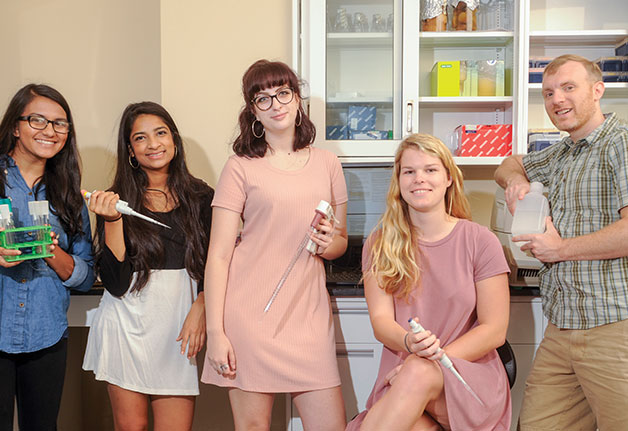The Great Barrier Reef is dying, and a group from Wofford College has joined global efforts to address the problem.
“Coral bleaching is a big threat,” says Dr. Geoffrey Mitchell, assistant professor of biology at Wofford. “Coral reefs are the rainforests of the ocean. They’re among the most biodiverse places on the planet and are important to the world’s food supply, not to mention the multibillion-dollar tourist industry that the reefs support.”
Bleaching occurs when coral expel the algae that live inside them; their relationship is symbiotic. Without the nutrients provided by the algae, the coral lose their color and soon die. A heat wave in 2016 left 90 percent of the Great Barrier Reef with evidence of bleaching.
During the past summer each student worked on a different piece of the puzzle, but Mitchell says the bulk of the work involved trying to determine how coral and algae maintain their connection. Because coral is difficult to grow in the lab, the students used anemones and their own endosymbiotic algae.
“For example,” says Mitchell, “Kajal Patel ’18 (a psychology major from Philadelphia, Pa.) and Madalyn Snoddy ’18 (a biology and Spanish major from Columbia, S.C.) isolated anemone cells and subjected them to higher temperatures to see how cells change. One hypothesis is that high temperatures cause the algae to divide too much, and they take over so the coral are no longer able to control the growth. When this happens they spit out the algae.”
Lacey Tallent ’18 of Spartanburg would love to be among the first to demonstrate the hypothesis in the lab. The biology major with an emphasis in computer science plans a career in research. “Research can be both rewarding and frustrating, but I enjoy it because you never know what’s going to happen.”
This summer’s research was a continuation of similar research directed by Mitchell during 2016. The goal is to share the findings with the scientific community in the form of papers and presentations. For the Wofford students, the goal also is to prepare for careers in medicine, bioinformatics or scientific research.
By Jo Ann Mitchell Brasington ’89
